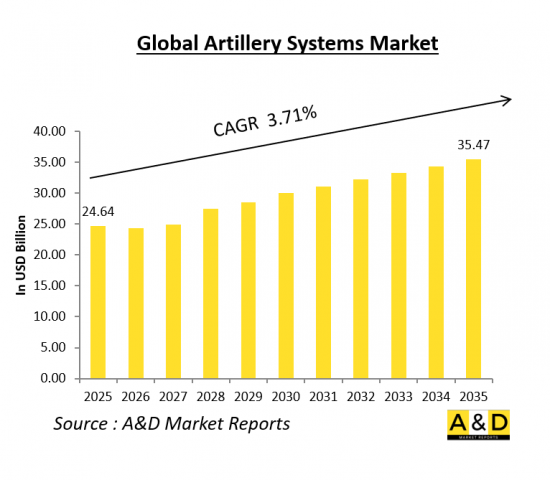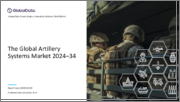
|
시장보고서
상품코드
1664191
세계의 포병 시스템 시장(2025-2035년)Global Artillery Systems Market 2025-2035 |
||||||
세계 포병 시스템 시장은 안정적인 성장을 보이고 있으며, 2025년 시장 규모는 추정 246억 4,000만 달러이며, 2035년까지 354억 7,000만 달러에 이를 것으로 예측됩니다. 시장은 예측기간에 CAGR 3.71%의 확대가 예상됩니다. 이 성장은 육상포, 로켓시스템, 자주류탄포 등 다양한 군사 용도에서 포병 시스템에 대한 지속적인 수요를 반영합니다.

포병 시스템 시장의 소개
포병 시스템 시장은 현대 방어 전략에 필수적인 구성 요소이며 전장에서 화력 지원, 전략적 억제 및 전력 투사에 중요한 역할을합니다. 포병 시스템에는 자주식 및 견인식 류탄포, 다연장 로켓 시스템(MLRS), 박격포, 연안 방위포 등 다양한 무기가 포함됩니다. 이 시스템은 적의 진지와 요새, 장갑 부대에 장거리, 높은 충격의 화력을 부여하는 데 필수적입니다.
세계 포병 시장은 방어 예산 증가, 군사 교리 진화, 정확성과 화력 강화의 필요성으로 안정적인 성장을 보여줍니다. 세계 각국은 경쟁력을 유지하고 복잡화하는 현대전에 대응하기 위해 최신 포병 솔루션에 투자하고 있습니다. 지정학적 긴장과 지역분쟁의 격화는 첨단 포병 시스템에 대한 수요를 더욱 높여 사정거리, 정밀도, 기동성, 자동화를 강화하는 연구개발에 대한 투자를 촉진하고 있습니다.
포병 시스템 시장의 주요 촉진요인
진화하는 군사 전략, 방어 근대화 프로그램, 새로운 안보 위협 등 여러 요인들이 포병 시스템 시장의 확대를 촉진하고 있습니다. 각국은 변화하는 전쟁역학에 대응하고, 화력, 정밀도, 작전효과를 강화하기 위해 포병의 업그레이드를 우선하고 있습니다. 주요 촉진요인 중 하나는 장거리 공격 능력에 대한 관심 증가입니다. 군은 원거리 대상을 더 높은 정확도로 공격하기 위해 첨단 포병 솔루션에 투자하고 있습니다. 기존의 간접 화력 지원에서 정밀 공격 능력으로의 이동은 유도 포 시스템과 스마트 탄약 수요에 박차를 가하고 있습니다. 지정학적 긴장과 국경 분쟁은 포병 조달을 더욱 가속화하고 있습니다. 특히 동유럽, 중동, 인도 태평양 등 지역에서 안보 위협에 직면한 국가들은 억지력을 강화하고 신속한 대응 능력을 확보하기 위해 포병 능력을 강화하고 있습니다. 또한 NATO와 같은 다자간 동맹은 집단 방어 전략의 일환으로 포병 근대화를 계속 중시하고 있습니다.
또 다른 중요한 촉진요인은 네트워크 중심 전쟁의 역할 증가입니다. 포병 시스템은 디지털 전투 네트워크에 통합되어 정찰 드론, 위성 감시, 지휘 통제 센터 등 기타 군사 자산과의 원활한 연계를 가능하게 합니다. 이 연결성은 상황 인식을 강화하고 보다 효율적인 화력 지원 임무를 가능하게 합니다.
비용 효율성과 지속가능성도 포병 조달 동향에 영향을 미칩니다. 각국 정부는 물류 부담을 최소화하면서 높은 화력을 제공하는 포병 솔루션을 찾고 있습니다. 모듈형 설계, 공통 탄약 구경, 유지 보수 요건의 감소는 전투 효과를 손상시키지 않고 자원을 최적화하려는 군사 계획자에게 중요한 고려 사항입니다.
게다가 국내 방위 제조 동향 증가가 포병 시장에서의 경쟁에 박차를 가하고 있습니다. 각국은 외국공급업체에 대한 의존도를 줄이고 국방산업을 활성화하기 위해 국내 생산을 중시하고 있습니다. 이를 통해 특정 운영 요구에 맞는 차세대 포병 솔루션 개발에 중점을 둔 R&D 활동이 활발해지고 있습니다.
포병 시스템 시장의 지역 동향
포병 시스템 시장은 안보 과제, 군사 예산, 전략적 제휴의 영향을 받아 명확한 지역 동향을 보여줍니다. 각 지역은 방어 요구 사항과 지정 학적 상황에 따라 특정 포병의 진보를 우선시합니다.
이 보고서는 세계 포병 시스템 시장에 대한 조사 분석을 통해 시장 성장 촉진요인, 10년간 시장 예측, 각 지역 동향 등의 정보를 제공합니다.
목차
포병 시스템 시장 보고서 정의
포병 시스템 시장의 세분화
지역별
유형별
범위별
향후 10년간 포병 시스템 시장 분석
포병 시스템 시장 시장 기술
세계 포병 시스템 시장 예측
지역 포병 시스템 시장 동향과 예측
북미
촉진요인, 억제요인, 과제
PEST
시장 예측 및 시나리오 분석
주요 기업
공급자의 Tier 상황
기업 벤치마킹
유럽
중동
아시아태평양
남미
포병 시스템 시장의 국가 분석
미국
방어 프로그램
최신 뉴스
특허
이 시장의 현재 기술 성숙도
시장 예측 및 시나리오 분석
캐나다.
이탈리아
프랑스
독일
네덜란드
벨기에
스페인
스웨덴
그리스
호주
남아프리카
인도
중국
러시아
한국
일본
말레이시아
싱가포르
브라질
포병 시스템 시장 기회 행렬
포병 시스템 시장 보고서에 대한 전문가의 의견
결론
Aviation and Defense Market Reports 정보
JHS 25.03.14The global artillery systems market is poised for steady growth, with an estimated value of USD 24.64 billion in 2025, projected to reach USD 35.47 billion by 2035. The market is expected to expand at a Compound Annual Growth Rate (CAGR) of 3.71% over the forecast period. This growth reflects the sustained demand for artillery systems across various military applications, including land-based artillery, rocket systems, and self-propelled howitzers.

Introduction to Artillery Systems Market
The artillery systems market is a vital component of modern defense strategies, playing a critical role in providing firepower support, strategic deterrence, and force projection on the battlefield. Artillery systems encompass a range of weaponry, including self-propelled and towed howitzers, multiple launch rocket systems (MLRS), mortars, and coastal defense artillery. These systems are essential for delivering long-range, high-impact firepower against enemy positions, fortifications, and armored units.
The global artillery market has experienced steady growth due to rising defense budgets, evolving military doctrines, and the need for enhanced precision and firepower. Nations worldwide are investing in modern artillery solutions to maintain a competitive edge and address the growing complexity of modern warfare. Increasing geopolitical tensions and regional conflicts have further driven demand for advanced artillery systems, prompting investments in research and development to enhance range, accuracy, mobility, and automation.
Technology Impact in Artillery Systems Market
Technological advancements have significantly influenced the artillery systems market, leading to greater precision, improved mobility, and enhanced interoperability. Modern artillery platforms are increasingly integrating digital fire control systems, automation, and network-centric capabilities to optimize battlefield effectiveness. One of the most transformative innovations is the development of precision-guided munitions (PGMs), which have revolutionized artillery accuracy and reduced collateral damage. Advanced guidance systems, such as GPS, laser, and inertial navigation, enable artillery shells to strike targets with high precision, reducing the requirement for mass bombardment. Additionally, smart artillery shells, equipped with data-link connectivity, allow real-time target updates and in-flight course correction. Extended-range capabilities have also seen substantial improvements with advancements in rocket-assisted projectiles (RAP) and ramjet-powered munitions. These technologies enable artillery systems to engage targets at distances exceeding 70-100 km, significantly enhancing their strategic reach. The integration of autonomous and AI-driven fire control systems further streamlines targeting processes, ensuring rapid response and reducing human error in combat scenarios.
Another notable advancement is the adoption of modular and multi-role artillery platforms. Modern self-propelled howitzers and MLRS systems are now designed with greater adaptability, enabling quick configuration changes to suit different mission profiles. This flexibility is particularly valuable in multi-domain operations where artillery units must coordinate with air, land, and naval forces seamlessly.
Automation and robotics are also making their way into the artillery domain, with automated loading systems and remote-controlled artillery units improving operational efficiency. Unmanned artillery systems are in development, leveraging AI and machine learning to enhance decision-making, surveillance, and targeting without direct human intervention. These innovations are shaping the future of artillery warfare, making systems more effective, survivable, and adaptable to modern combat environments.
Key Drivers in Artillery Systems Market
Several factors are driving the expansion of the artillery systems market, including evolving military strategies, defense modernization programs, and emerging security threats. Nations are prioritizing artillery upgrades to enhance firepower, precision, and operational effectiveness in response to changing warfare dynamics. One of the primary drivers is the increasing focus on long-range strike capabilities. Military forces are investing in advanced artillery solutions to engage targets at greater distances with enhanced accuracy. The shift from conventional indirect fire support to precision-strike capabilities has spurred demand for guided artillery systems and smart munitions. Geopolitical tensions and border disputes have further accelerated artillery procurements. Countries facing security threats, particularly in regions like Eastern Europe, the Middle East, and the Indo-Pacific, are bolstering their artillery capabilities to strengthen deterrence and ensure rapid response capabilities. Additionally, multinational alliances such as NATO continue to emphasize artillery modernization as part of collective defense strategies.
Another key driver is the increasing role of network-centric warfare. Artillery systems are being integrated into digital battle networks, allowing seamless coordination with other military assets, including reconnaissance drones, satellite surveillance, and command-and-control centers. This connectivity enhances situational awareness and enables more efficient fire support missions.
Cost-efficiency and sustainability are also influencing artillery procurement trends. Governments are seeking artillery solutions that offer high firepower while minimizing logistical burdens. Modular designs, common ammunition calibers, and reduced maintenance requirements are key considerations for military planners looking to optimize resources without compromising combat effectiveness.
Additionally, the growing trend of indigenous defense manufacturing has spurred competition in the artillery market. Countries are emphasizing domestic production to reduce reliance on foreign suppliers and boost national defense industries. This has led to increased research and development initiatives focused on developing next-generation artillery solutions tailored to specific operational needs.
Regional Trends in Artillery Systems Market
The artillery systems market exhibits distinct regional trends, influenced by security challenges, military budgets, and strategic alliances. Different regions are prioritizing specific artillery advancements based on their defense requirements and geopolitical landscapes.
In North America, the United States remains a dominant player in the artillery market, investing heavily in next-generation systems to maintain battlefield superiority. The U.S. Army's Extended Range Cannon Artillery (ERCA) program is a prime example of efforts to enhance range and precision. The U.S. military is also developing advanced MLRS platforms and smart munitions to support multi-domain operations. Canada is also strengthening its artillery capabilities, focusing on interoperability with NATO forces.
Europe is witnessing increased artillery investments due to the evolving security environment, particularly in response to Russia's actions in Ukraine. NATO member states, including Germany, France, and Poland, are modernizing their artillery arsenals to bolster collective defense. European defense companies are actively developing advanced howitzers, MLRS, and smart munitions, with multinational collaborations playing a crucial role in artillery procurement.
The Asia-Pacific region is experiencing significant artillery expansion due to territorial disputes and rising military expenditures. Countries such as India, China, South Korea, and Japan are investing in cutting-edge artillery systems to strengthen their land-based deterrence capabilities. India has been procuring and developing indigenous artillery solutions, including the Dhanush and ATAGS howitzers, while China continues to advance its artillery arsenal with long-range and precision-strike capabilities. South Korea, known for its K9 Thunder self-propelled howitzer, has emerged as a key player in the global artillery export market.
In the Middle East, ongoing conflicts and regional security concerns have driven demand for artillery systems. Nations such as Saudi Arabia, the UAE, and Israel have been procuring modern artillery platforms to enhance their defensive and offensive capabilities. Israel, in particular, has been at the forefront of artillery innovation, incorporating advanced targeting and automation features into its systems.
Africa and Latin America have seen relatively slower artillery procurement, with acquisitions primarily focused on upgrading existing systems rather than large-scale modernization. However, some nations in these regions are exploring new artillery acquisitions to improve border security and counter-insurgency operations.
The global artillery systems market is set for continued growth, driven by technological advancements, evolving military doctrines, and regional security dynamics. As countries seek to enhance their artillery capabilities with longer ranges, greater precision, and improved mobility, the industry is expected to witness further innovation and collaboration among defense manufacturers and military stakeholders. The increasing role of digital integration, automation, and indigenous manufacturing will shape the future of artillery warfare, ensuring that modern forces remain well-equipped to address emerging threats and operational challenges.
Key Artillery Systems Programs
On December 20, 2024, the Defence Ministry signed a ₹7,629 crore contract with Larsen & Toubro (L&T) for the procurement of 100 additional 155mm/52 calibre K9 Vajra-T self-propelled tracked artillery guns for the Indian Army. According to the Ministry, these advanced guns, equipped with cutting-edge technology, are capable of delivering long-range, highly accurate, and rapid fire. Additionally, they are designed to operate at peak efficiency even in sub-zero temperatures in high-altitude regions. The project is expected to generate over nine lakh man-days of employment over four years, with active participation from various Indian industries, including MSMEs. During heightened tensions in Eastern Ladakh, the Army deployed a regiment of K9 Vajra self-propelled howitzers to strengthen its long-range firepower in response to a significant Chinese military buildup. Developed by L&T with technology transfer from South Korean defense giant Hanwha Defence, the K9 Vajra has demonstrated exceptional performance. As a result, the Army is now considering acquiring an additional 200 guns in two phases. Originally intended for desert operations, the K9 Vajra was adapted for deployment in mountainous terrain due to the ongoing standoff with China.
Elbit Systems announced that it has secured a contract valued at approximately $102 million to supply artillery systems to an international customer. The contract will be executed over a period of eight years. As part of the agreement, Elbit Systems will deliver a full battalion of ATMOS (Autonomous Truck Mounted Howitzer) 155mm/52 caliber truck-mounted howitzers. The ATMOS is a combat-proven, modular wheeled artillery system capable of firing all NATO-certified 155mm projectiles. It has an effective range exceeding 40 km with standard munitions and can achieve even greater distances using Rocket-Assisted Projectiles (RAP). Designed for rapid deployment and high mobility, the ATMOS provides versatile fire support for a wide range of operational missions.
Table of Contents
Artillery Systems Market Report Definition
Artillery Systems Market Segmentation
By Region
By Type
By Range
Artillery Systems Market Analysis for next 10 Years
The 10-year Artillery Systems Market analysis would give a detailed overview of Artillery Systems Market growth, changing dynamics, technology adoption overviews and the overall market attractiveness is covered in this chapter.
Market Technologies of Artillery Systems Market
This segment covers the top 10 technologies that is expected to impact this market and the possible implications these technologies would have on the overall market.
Global Artillery Systems Market Forecast
The 10-year Artillery Systems Market forecast of this market is covered in detailed across the segments which are mentioned above.
Regional Artillery Systems Market Trends & Forecast
The regional Artillery Systems Market trends, drivers, restraints and Challenges of this market, the Political, Economic, Social and Technology aspects are covered in this segment. The market forecast and scenario analysis across regions are also covered in detailed in this segment. The last part of the regional analysis includes profiling of the key companies, supplier landscape and company benchmarking. The current market size is estimated based on the normal scenario.
North America
Drivers, Restraints and Challenges
PEST
Market Forecast & Scenario Analysis
Key Companies
Supplier Tier Landscape
Company Benchmarking
Europe
Middle East
APAC
South America
Country Analysis of Artillery Systems Market
This chapter deals with the key defense programs in this market, it also covers the latest news and patents which have been filed in this market. Country level 10 year market forecast and scenario analysis are also covered in this chapter.
US
Defense Programs
Latest News
Patents
Current levels of technology maturation in this market
Market Forecast & Scenario Analysis
Canada
Italy
France
Germany
Netherlands
Belgium
Spain
Sweden
Greece
Australia
South Africa
India
China
Russia
South Korea
Japan
Malaysia
Singapore
Brazil
Opportunity Matrix for Artillery Systems Market
The opportunity matrix helps the readers understand the high opportunity segments in this market.
Expert Opinions on Artillery Systems Market Report
Hear from our experts their opinion of the possible analysis for this market.
Conclusions
About Aviation and Defense Market Reports



















